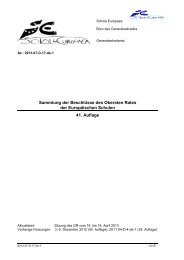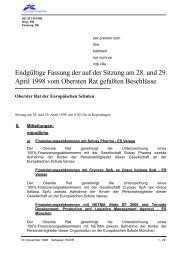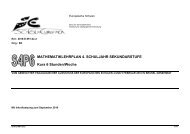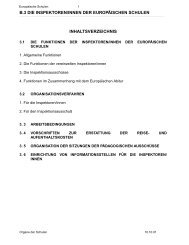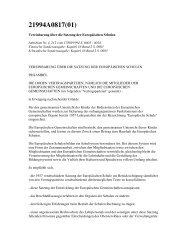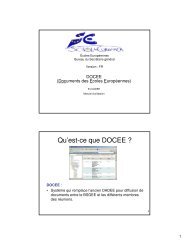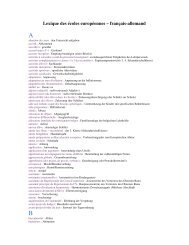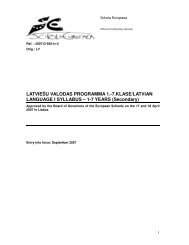External Evaluation of the European Baccalaureate (Annexes)
External Evaluation of the European Baccalaureate (Annexes)
External Evaluation of the European Baccalaureate (Annexes)
Create successful ePaper yourself
Turn your PDF publications into a flip-book with our unique Google optimized e-Paper software.
DIFFEREN<br />
TIATION<br />
• Of <strong>the</strong> product <strong>of</strong> a continuous<br />
function with a real number<br />
• Of <strong>the</strong> sum, product, quotient ,<br />
composition <strong>of</strong> two continuous<br />
functions<br />
• Continuity over ∇<strong>of</strong> polynomial<br />
functions<br />
• Continuity <strong>of</strong> rational functions<br />
over <strong>the</strong>ir domain<br />
Limits<br />
• Notion <strong>of</strong> a limit <strong>of</strong> a function at<br />
a point<br />
• Removable continuity<br />
• Right hand limit <strong>of</strong> a function at<br />
a point<br />
• Extension <strong>of</strong> <strong>the</strong> notion <strong>of</strong> limit,<br />
infinite limit, limit as <strong>the</strong><br />
variable tends to +∞ and - ∞<br />
• Statement without pro<strong>of</strong> <strong>of</strong><br />
<strong>the</strong>orems concerning limits<br />
• Of <strong>the</strong> absolute value <strong>of</strong> a<br />
function<br />
• Of <strong>the</strong> product <strong>of</strong> a function<br />
with a real number<br />
• Of <strong>the</strong> sum, product, quotient,<br />
composition <strong>of</strong> two functions<br />
• Indeterminant forms<br />
No guidance given for time<br />
allocation<br />
• Value <strong>of</strong> derivative <strong>of</strong> a<br />
function at a given point<br />
• Geometrical interpretation<br />
• Equation <strong>of</strong> <strong>the</strong> tangent at a<br />
point on <strong>the</strong> graph <strong>of</strong> a function<br />
• Derivative <strong>of</strong> a function<br />
• Successive derivatives<br />
• Derivative <strong>of</strong> a product <strong>of</strong> a<br />
differentiable function with a<br />
real number<br />
• Derivative <strong>of</strong> <strong>the</strong> sum, product,,<br />
quotient and composition <strong>of</strong><br />
two differentiable functions<br />
• L’hospitals rule<br />
• application <strong>of</strong> <strong>the</strong> notions <strong>of</strong><br />
limits and derivatives to <strong>the</strong><br />
analysis <strong>of</strong> a function<br />
52<br />
C1<br />
• understand gradient <strong>of</strong> curve as <strong>the</strong> limit<br />
<strong>of</strong> <strong>the</strong> gradients <strong>of</strong> a sequence<br />
• understand <strong>the</strong> idea <strong>of</strong> a derived function<br />
and second order function, use<br />
appropriate notation<br />
• use derivative for xⁿ<br />
• apply differentiation to gradients, tangent<br />
and normals, rates <strong>of</strong> change, increasing<br />
and decreasing functions and location <strong>of</strong><br />
stationary points<br />
C3<br />
• use derivatives <strong>of</strong> e ⁿ and ln x<br />
• differentiate composite functions using<br />
<strong>the</strong> chain rule<br />
• differentiate products and quotients<br />
• apply differentiation to connected rates <strong>of</strong><br />
change<br />
C4<br />
• use derivatives <strong>of</strong> sin x, cos x, tan x<br />
• find and use <strong>the</strong> first derivative <strong>of</strong> a<br />
function defined parametrically or<br />
implicitly<br />
• extend <strong>the</strong> idea <strong>of</strong> reverse differentiation<br />
• formulate a simple statement involving



